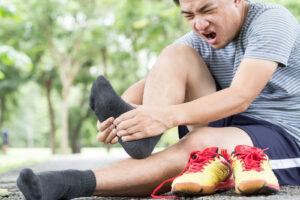The arch of the foot is the curved midsection stretching along the bottom of your foot between the ball and the heel. It actually comprises three arches that form a triangular shape: two longitudinal arches (media and lateral) and a transverse arch. Each arch is made up of bones, ligaments, and tendons into a ‘springy’ structure for absorbing shock, bearing the foot’s weight, stabilising movement and maintaining balance.
The arch is a vital part of the foot that’s always under pressure or tension when walking, standing or sitting. Unfortunately, pain in this area is a common problem, especially among athletes. For some, the pain might be just a slight nag, while for others, it can be agonising or even crippling at its worst. Let’s take a look at the symptoms, causes and treatment of arch pain.
Arch pain symptoms
Symptoms of arch pain vary from person to person and also depending on the cause. You should see a podiatrist if you experience unrelenting pain in the arch of the foot or any of these symptoms:
- Arch pain that worsens throughout the day
- Sharp arch pain in the morning that fades after walking around
- Temporary pain after lifting weight or stretching the foot
- A continuously burning pain during rest or while walking
- Cramps in the arch area
Causes of arch pain
Arch pain occurs when structural tissues within the arches become aggravated through aging, physical stress or neurological issues. Below are the common conditions for arch pain.
Plantar fasciitis
This is the most common cause of arch pain. The pain results from damage or inflammation of the plantar fascia – a ligament connecting the front of the foot to the heel. The pain starts as a stiffness in the arch and worsens when the foot comes under pressure. We often see plantar fasciitis in athletes, particularly runners.
Overpronation
Overpronation refers to a foot movement where the outer portion of the heel hits the ground first while walking. In doing so, the foot rolls too far inward onto the arch, causing it to flatten over time. Ultimately, this causes damages to supportive arch ligaments, muscles and tendons, resulting in pain.
Cavus foot
Cavus foot is an inherited or neurological condition where the foot develops an abnormally high arch. People with cavus foot mostly experience pain while walking or standing due to the extra strain on their arches.
Posterior tibial tendon dysfunction (PTTD)
PTTD occurs when the posterior tibial, a tendon that connects the inner part of the foot to one of the calf muscles, becomes inflamed or injured and can no longer support the arch. The pain can stretch from the arch and the inner part of the ankle to the back of the leg when walking or running.
Arch pain treatments and remedies
Occasional arch pain or soreness is nothing to worry about. Simple remedies such as foot rubs, stretching or even rest can easily relieve arch pain from a short run or exercise session. But if you experience recurring or persistent arch pain, you need to seek professional help.
The podiatrist will first diagnose the root cause of the pain before recommending the appropriate treatment approach. Potential treatments range from physical therapy, anti-inflammation medications, foot casts and braces to surgery, depending on the pain’s cause.
Get help for your arch pain ASAP
Seek professional medical attention if you’re worried about your arch pain. Even a slight discomfort in the arch can be an early indication of a more severe underlying problem.
Let our team of dedicated podiatrists at Be Podiatry relieve your arch pain. Our proven diagnosis and treatment methods are designed to identify and remedy the underlying root cause of the pain – not just the symptoms. Book an appointment online or visit our clinic at 31 Beewar St, Greensborough VIC 3088 today and take your first step to excellent foot health.
